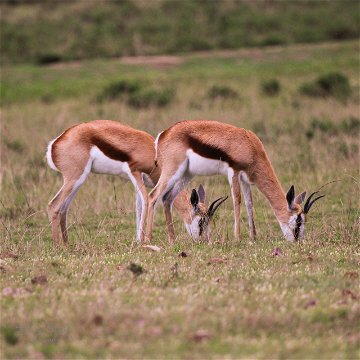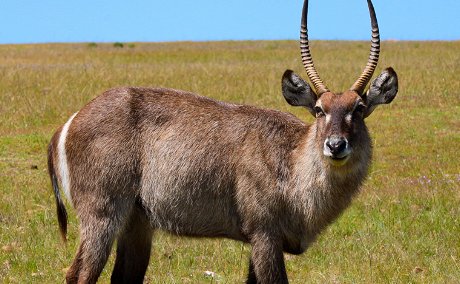Latin Name: Connochaetes Taurinus Also knows as the Golden Gnu Golden Wildebeest naturally occurred along the Limpopo River basin, adjacent to the Tuli-Block of Botswana. Early farmers in the1920’s, called them “Vos Wildebeest” The first Golden Wildebeest Bull was captured by Alec Rough in the early 1990’s on the game farm Swinburne, in the Limpopo Valley. This is the area where the majority of Golden Wildebeest originate from. They formed an integral...
Wildlife Facts - Springbok

Latin Name: Antidorcas marsupialis
Springbok has long, pointed ears, long neck and slender body. Lyre-shaped horns can be seen both in males and females (they are longer and thicker in males). Springbok is active at dusk and dawn (crepuscular animal). Springbok are herbivores (plant-eater).
- Springbok are widely distributed throughout South Africa and is also the National Animal of South Africa.
- They are highly gregarious and move around in large herds. In previous times they used to trek in herds of thousands. Herds consist of rams and ewes with young lambs and sub adults and bachelor herds (young and old rams). Territorial rams will try and keep herds of ewes in breeding season and defend them against other rams until they move on away from one ram’s territory to graze in another ram’s territory.
- The Springbok is one of South Africa’s most successful game farm animals to breed.
- Traditionally they prefer the colder inland plato, Karoo and especially the Kalahari region with shrub, bush, open short grassveld and shrubveld, as well as open arid plains. Springbok is very adaptable and they have shown that they readily adapt to most habitats.
- Male (Ram) Mass: Can weigh up to about 41 Kilograms
- Female (Ewe) Mass: Can weigh up to about 37 Kilograms
- There are some Springbok that are totally black or totally white.
- When disturbed, Springbok commence running and bound and leap (repeatedly) into the air with stiff extended legs, with the males or rams raising the hairs of the dorsal crest extending from the back to the tail (the rams). These bounds may reach 2 to 3 meters and this leaping is known as “pronking”. This “pronking” could also be seen when the rams are rutting and defending their territories and female herds against other rams with the intention to impress the females or ewes.
- Lambs are born mainly in summer and during the rainy season, from November to February in the northern parts of the country and some during July in Cape areas, but it could often be any time of the year depending on the area or region, availability and supply of food and climate. Newly born lambs are hidden away for a few days under tall grass or shrubs.
- Their lifespan is up to 10 years.
- The Springbok is the legendary emblem of South Africa's official national Rugby Team - The Springbucks
Come and meet them at Hartenbos Private Game Lodge
Further Reading
Latin Name: Damaliscus pygargus The Bontebok is a medium-sized, generally dark brown antelope with a prominent, wide white blaze on its face, with a pure white rump, belly and hocks, and black-tipped tail. Both sexes have horns, although the horns of rams are heavier and longer than those of ewes.
Latin Name: Kobus ellipsiprymnus Hence their name, waterbuck tend to hang around areas where there is a lot of water, especially being water dependent animals. Bulls (males) in particular, will hold a territory where there is an abundant amount of water and food to attract females – he will only hold this territory in breeding seasons.







Share This Post